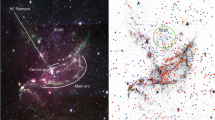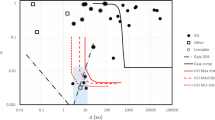Abstract
Kuiper-belt objects (KBOs) are an ancient reservoir of comets beyond Neptune's orbit1,2. Some of these objects were recently found to have the reddest optical colours in the Solar System3, but the number of objects for which accurate colours were available was too small for any correlation to be discerned between colour and physical or dynamical properties, which might shed light on the origin of these objects. Here we report that all nine of the KBOs in our survey on near-circular (low-eccentricity) orbits with perihelion distances larger than 40 AU have extremely red surfaces, thereby connecting an observable property with a dynamical class. Of the objects with orbital eccentricities greater than 0.1, about half are also very red, while the rest have colours similar to the Sun, meaning that reflected sunlight is not strongly modified by the objects' surface properties. In addition, of the 13 ‘classical’ KBOs (those with semimajor axis a ≈ 45 AU and eccentricity e < 0.15), the ten that are very red are in orbits with small angles of inclination to the ecliptic, whereas the three with solar colours are all in high-inclination orbits. We suggest that these three ‘grey’ classical KBOs may be part of a dynamical group that is separate from the ‘red’ classical KBOs.
This is a preview of subscription content, access via your institution
Access options
Subscribe to this journal
Receive 51 print issues and online access
$199.00 per year
only $3.90 per issue
Buy this article
- Purchase on Springer Link
- Instant access to full article PDF
Prices may be subject to local taxes which are calculated during checkout


Similar content being viewed by others
References
Jewitt, D. & Luu, J. Discovery of the candidate Kuiper belt object 1992 QB1. Nature 362, 730– 732 (1993).
Marsden, B. G. List of transneptunian objects. (Cited June 2000) <http://cfa-www.harvard.edu/cfa/ps/lists/TNOs.html> (2000).
Tegler, S. C. & Romanishin, W. Two distinct populations of Kuiper-belt objects. Nature 392, 49– 51 (1998).
Oke, J. B. et al. The Keck Low Resolution Imaging Spectrometer. Publ. Astron. Soc. Pacif. 107, 375–385 (1995).
Landolt, A. U. UBVRI photometric standard stars in the magnitude range 11.5 < V < 16.0 around the celestial equator. Astron. J. 104, 340–371 (1992).
Romanishin, W., Tegler, S. C., Levine, J. & Butler, N. BVR photometry of centaur objects 1995 GO, 1993 HA2, and 5145 Pholus. Astron. J. 113, 1893–1898 (1997).
Tegler, S. C. & Romanishin, W. The extraordinary colors of trans-neptunian objects 1994 TB and 1993 SC. Icarus 126, 212–217 (1997).
Tegler, S. C., Romanishin, W., Stone, A., Tryka, K., Fink, U. & Fevig, R. Photometry of the trans-neptunian object 1993 SC. Astron. J. 114, 1230–1233 (1997).
Malhotra, R. The origin of Pluto's orbit: implications for the solar system beyond Neptune. Astron. J. 110, 420–429 (1995).
Acknowledgements
We thank the NASA Planetary Astronomy programme for financial support of this research and the NASA Keck Telescope Allocation Committee for consistent allocation of telescope time.
Author information
Authors and Affiliations
Corresponding author
Rights and permissions
About this article
Cite this article
Tegler, S., Romanishin, W. Extremely red Kuiper-belt objects in near-circular orbits beyond 40 AU. Nature 407, 979–981 (2000). https://doi.org/10.1038/35039572
Received:
Accepted:
Issue Date:
DOI: https://doi.org/10.1038/35039572
This article is cited by
-
Origin and Evolution of the Cometary Reservoirs
Space Science Reviews (2015)
-
Photometry of Transneptunian Objects for the Herschel Key Program ‘TNOs are Cool’
Earth, Moon, and Planets (2014)
Comments
By submitting a comment you agree to abide by our Terms and Community Guidelines. If you find something abusive or that does not comply with our terms or guidelines please flag it as inappropriate.



